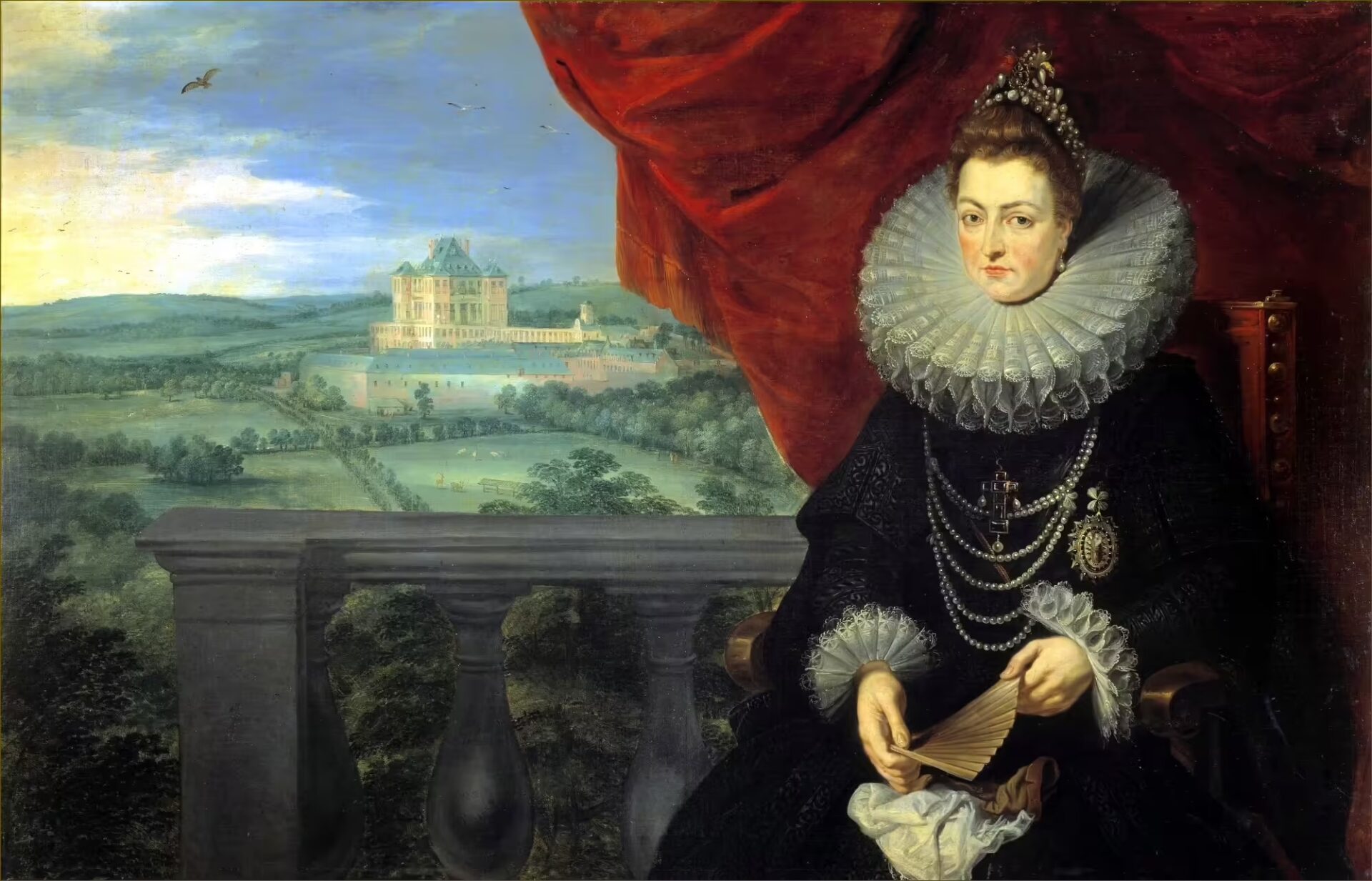The streets of Brussels were decked out on September 5, 1599, for the Joyeuse Entrée, the ceremonial royal entry into the city of Archdukes Isabella and Albert, the new rulers of the Habsburg Netherlands.
Crowds cheered them on their way to the Coudenberg Palace, for great expectations were placed on the newlywed couple. For almost half a century, Philip II of Spain, Isabella’s father, had ruled the Netherlands from Madrid through a series of governors, of which the Duke of Alba had been the most hated. Now Philip was dead, and one of his last acts had been to cede to his daughter and her husband the northern Habsburg territory that covers much of present-day Belgium and the Netherlands.
Decades of war sparked by the Dutch revolt and the self-proclaimed independence of the United Provinces of the Netherlands had devastated the southern provinces and drained Spanish finances. Philip hoped that sovereigns resident in the country could restore peace, secure the people’s loyalty and govern at less expense to Spain.
Flanders had long sought a sovereign of its own based at the Coudenberg rather than governors taking instructions from Madrid, and the people had not welcomed a ruler so enthusiastically since the days of Isabella and Albert’s Ghent-born grandfather Charles V. The popular Emperor, unlike Philip who visited Flanders only once and never learned its languages, would mingle easily among his Flemish subjects.
The Infanta Isabella Clara Eugenia and Archduke Albert of Austria were 33 and 40, respectively, at the time of their marriage. They had both grown up in the court of Philip II. Isabella, the King’s favourite child, had acted as his assistant, a task for which her intelligence and abilities fitted her. Albert, who was her cousin, had been educated at the Madrid court from childhood and chosen as the consort to co-reign with her over the Netherlands.
Would the new rulers display Charles V’s affability rather than the chilly formality of the Spanish court? Archduke Albert’s grave demeanour came as a disappointment, but his lack of charisma was offset by the Infanta Isabella’s approachability, reflecting the inherited charm of her French mother Elisabeth of Valois.
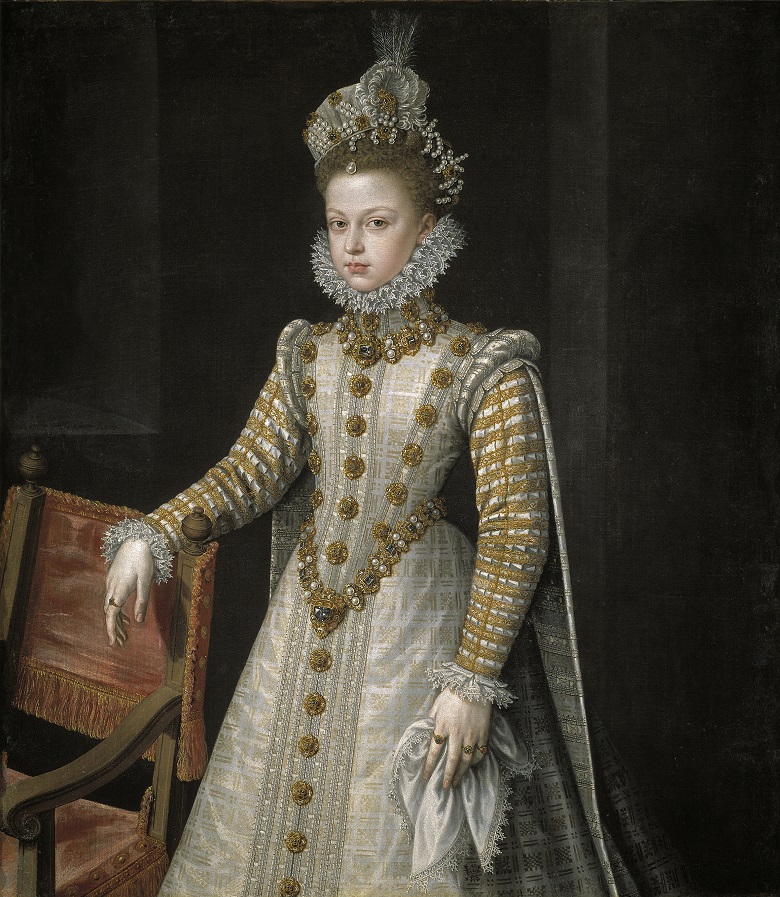
Isabella as Infanta
Isabella and Albert rode white horses for their entry into Brussels, fulfilling a prophecy that peace would come to Flanders if two newlyweds entered it as sovereigns mounted on white steeds. It rained all morning, but after a stop for prayer at the church of St Gudule’s, the sun came out. The change in the weather heralded a reign that was to be remembered as a bright interlude in the troubled history of the Spanish Netherlands – a golden age, in which Isabella played an important part. Reared in the gloomy Madrid court, a stranger to Flemish ways, she nevertheless quickly won the hearts of her new subjects.
Rallying the troops
Isabella found a country in ruins after 30 years of war (the Dutch Revolt would endure much longer, and is now known as the Eighty Years War). Fields went untilled as Spain’s unpaid, starving troops mutinied and pillaged the countryside, exacting contributions from farmers. Industry too was in decline, many artisans having emigrated to the United Provinces in the north.
There was much to be done to put the country in order, but the first years of the reign were dominated by conflict with the rebel provinces. A key aim was to recapture Ostend, held by the Dutch with English aid. During the siege of the seaside town, Isabella was often at Albert’s side to rally the troops, telling them she would rather pawn her jewels than see them go without pay.
The Siege of Ostend lasted for three years. Legend has it that Isabella vowed not to change her shift until the town was taken, during which time her undergarment gradually acquired the yellowish colour known as ‘Isabelline’. However, the story’s veracity blurs with a similar pledge made by Isabella I of Castile about the Siege of Granada.
After Ostend was finally taken, and with Philip II and his arch-enemy Elizabeth I both dead, peace was made with England after two decades of war, followed by a truce with the Dutch that would last 12 years.
The Archdukes secured this period of peace in the face of the Madrid government’s obstruction and aggressive foreign strategy. Flanders’ new sovereigns were never more than quasi-independent; in foreign policy, Spain still had the last word. As in the time of Philip II, decisions from Madrid were as slow to arrive as money to pay the troops. Philip III, Isabella’s procrastinating half-brother, only grudgingly accepted the cession of the Netherlands and was loath to leave decision-making to his sister and her husband.
The Archdukes met the King’s unrealistic demands with diplomacy and pragmatism. Isabella and Albert’s workaround to Madrid’s refusal to negotiate with the Northern Provinces as independent states was to simply treat the rebel provinces as if they were (official recognition of this de facto independence only came in 1648).
Regroup, restore, rebuild
The truce left the couple free to focus on rebuilding the country. They set about restoring security, encouraging industry and introducing lasting reforms such as a unified code of law.
Isabella ostensibly left the day-to-day management of affairs of state to her husband, anxious for him to retain authority as the visible face of government. However, observers were in no doubt that Albert, diligent but irresolute, relied heavily on his wife’s judgement. They were a close couple and worked well in tandem. Physically, Albert, short, slight and already suffering from hereditary gout, cut a somewhat puny figure by the side of his wife, who enjoyed robust health.
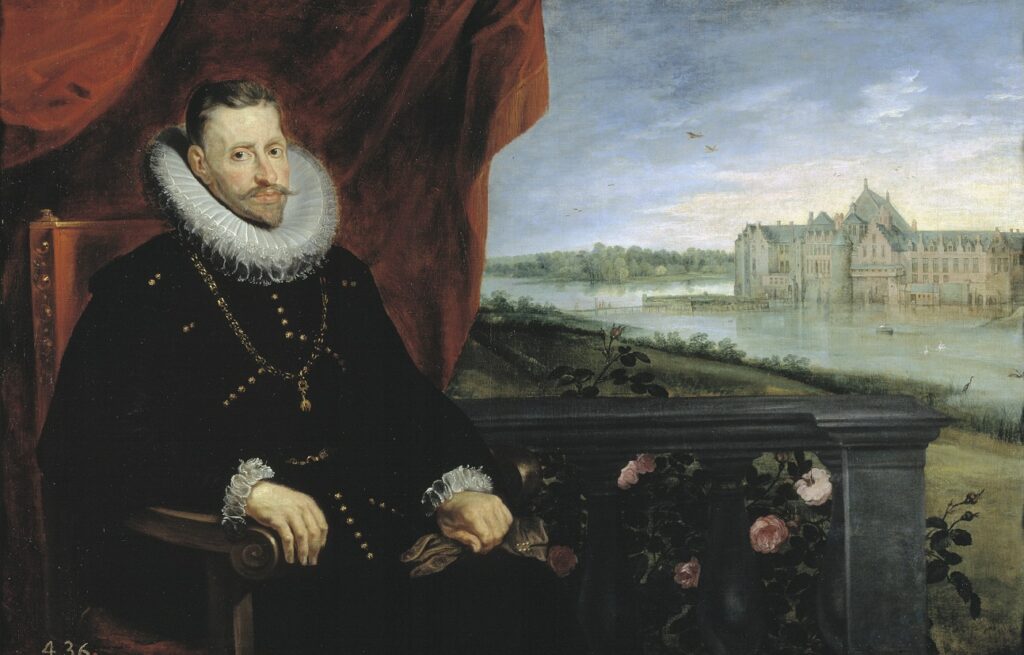
Archduke Albert with the Tervuren Castle in the background
Isabella mediated with Madrid on behalf of her Flemish subjects. She was an indefatigable letter writer, much of her correspondence being addressed to the Duke of Lerma, the court favourite, in attempts to explain the situation in Flanders and cajole funds out of King Philip III.
Flanders was never self-funding. Extra resources were always needed from Madrid and these were never forthcoming. “We’re doing our best for the King, but we can’t do anything without money,” was Isabella’s constant refrain.
But her letters were not all complaints. She gave a witty chronicle of life in Flanders while remembering those she left behind with fondness, including her “little brother” the King, despite his constant interference.
Her benevolence endeared her to Flemish nobles, whom the Archdukes wooed with ministerial appointments that Madrid would have preferred to give to Spaniards. Sympathising with her subjects’ aversion to rule (or misrule) by foreign ministers, Isabella stood up for their rights and privileges against arrogant Spanish ambassadors and grandees jockeying for power.
The Coudenberg court was much more jolly than the one in Madrid. Although the devout Infanta spent much time in prayer, she was far from averse to the festivities dear to the bon vivant Flemings. There were tournaments, plays and fêtes and the music-loving Isabella joined in the dancing at court balls. Both Archdukes were enthusiastic patrons of art, Rubens being their favourite among the court painters. ‘Pagan’ paintings were frowned upon – the prudish Albert had a picture of a scantily-clad Danaë removed – but the couple built up an impressive art collection.
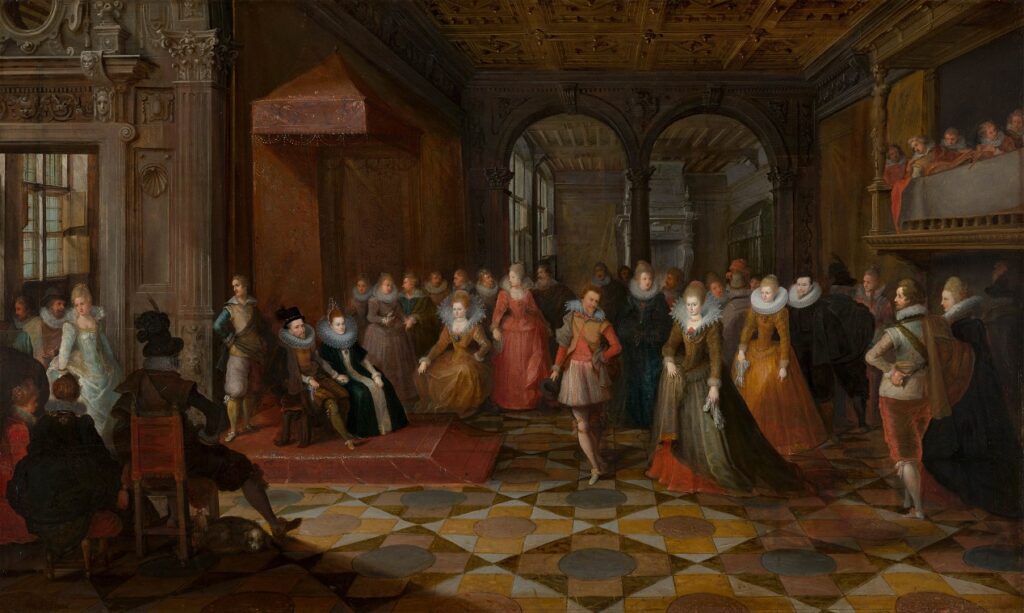
Isabella and Albert holding hands at a ball at the Coudenberg
Summers were spent at their country residence of Mariemont (now Morlanwelz), where Isabella could indulge her passion for hunting. In 1615 her skill with the crossbow won her plaudits in Brussels when she brought down the popinjay in her first attempt at the annual shooting contest of the Grand Serment des Arbalétriers, wielding the bow herself rather than delegating the task like her predecessors.
Our Lady of Laeken
There were two sides to Isabella’s nature. One was her joie de vivre and sense of fun. She had a penchant for practical jokes. She had artificial roses put on bushes in the palace gardens to fool a Polish visitor into believing that winters in Brussels were as mild as in Spain.
The other side of her character was her extreme piety. The Counter-Reformation had two of its most fervent promoters in Isabella and Albert. Strengthening Catholicism and the Church was a political as well as religious strategy, ‘heresy’ (Protestantism) being seen as a threat to the Habsburgs’ authority and therefore, stability. The Archdukes’ reign saw a proliferation of religious orders, processions, pilgrimages to shrines to venerate relics and miracle-working Virgins. Their brand of imported Catholicism with its “rule of priests” was blamed for subsequent failures by Flanders to throw off the Spanish yoke.
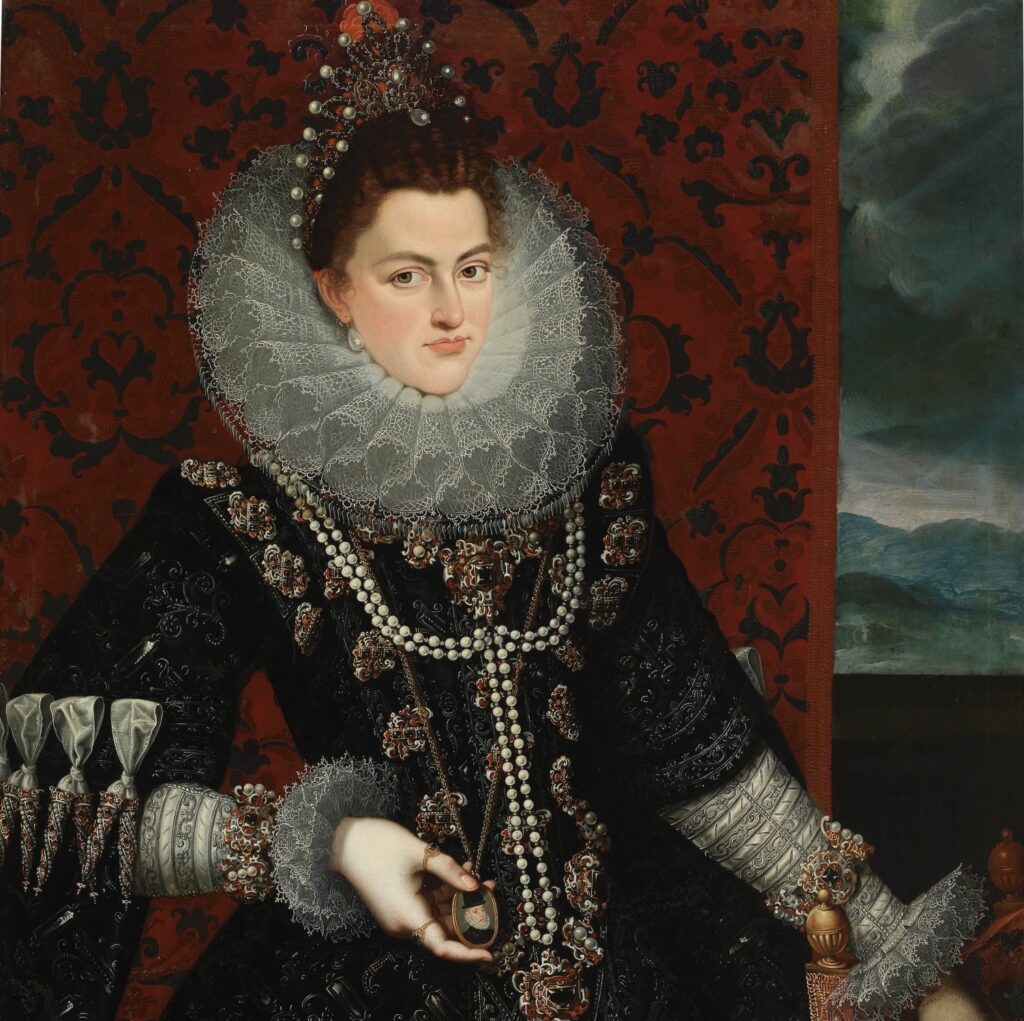
Isabella holding a pendant with a portrait of her father Philip II of Spain
Isabella herself spent much time on pilgrimages, particularly to the church at Laeken. She had a particular reason to visit. As the years passed she bore no children, and Our Lady of Laeken was believed to help women with fertility problems. A ribbon reputed to help women conceive was placed around the Infanta’s belly whenever she visited.
The Archduchess’s childlessness was much more than a matter of personal regret. Under the Act of Cession, any offspring of the Archdukes would rule after them and perpetuate the Netherlands’ own Habsburg dynasty, subject to the condition that these descendants must marry into the Spanish royal family.
The nun widow
But no children appeared, and following the Act of Cession, after Albert died in 1621 the Netherlands reverted to the Spanish throne. Isabella remained in Flanders as governor for life but sovereign no longer. Her wish to retire and end her days in a convent was not granted, for her popularity made her too useful to Madrid. As a second-best option, she joined the third (lay) order of St Francis and adopted the grey habit of a tertiary Franciscan, an incongruous figure among her courtiers. As governor, Isabella’s powers were more limited and her last years were overshadowed by the renewal of war.
Albert had been buried in the Chapel of the Holy Sacrament in St Gudule’s with all the pomp of a magnificent funeral procession, but when Isabella died in 1633 there was no money to give her a similar send-off. She was provisionally buried in the palace chapel and it took until 1650 to inter her in St Gudule’s by Albert’s side as she had wished. Her coffin was hurried there by night and in virtual secrecy on the orders of the governor at the time. A funerary monument for the couple had been designed but was never executed, due to both lack of funds and of space in the chapel.
But the Archdukes’ tomb had a troubled history. The vault was opened in 1780 to receive the remains of another popular governor, Charles of Lorraine. It was violated in 1793 when the cathedral was ransacked by French sans-culottes. And it was excavated in 1943 to verify and identify the remains, which were then reburied – the spot is marked by a marble slab bearing the terse inscription ‘Monumentum Belgii gubernatorum’. It seems unfair, to say the least, that Albert’s brother Ernest, governor for a single year before the Archdukes, has a splendid monument in the chancel complete with effigy, commissioned by Albert.
Perhaps to make up for the lack of a proper memorial, large paintings of Isabella and Albert are displayed near their burial place in the Chapel of the Holy Sacrament, which houses the cathedral museum. They are also depicted kneeling in prayer in a window dedicated to them in the Chapel of Our Lady of Deliverance opposite.
Isabella’s death was followed by economic decline and military disasters. Would Flanders have fared better had she and Albert founded a homegrown dynasty? It’s a question that must remain unanswered. But it surely would have done more than the string of short-lived governors who succeeded the golden age of Isabella.

